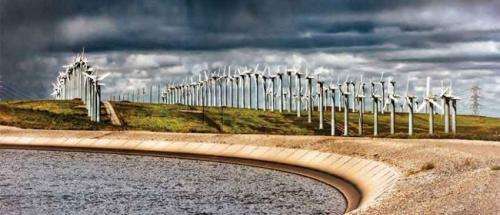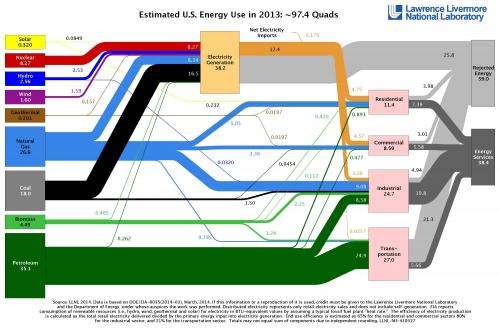Americans using more energy, analysis shows

(Phys.org) —Americans used more renewable, fossil and even nuclear energy in 2013, according to the most recent energy flow charts released by Lawrence Livermore National Laboratory.
Each year, the Laboratory releases energy flow charts that illustrate the nation's consumption and use of energy. Overall, Americans used 2.3 quadrillion thermal units more in 2013 than the previous year.
The Laboratory also has released a companion chart illustrating the nation's energy-related carbon dioxide emissions. Americans' carbon dioxide emissions increased to 5,390 million metric tons, the first annual increase since 2010.
Wind energy continued to grow strongly, increasing 18 percent from 1.36 quadrillion BTUs, or quads, in 2012 to 1.6 quads in 2013 (a BTU or British Thermal Unit is a unit of measurement for energy; 3,400 BTU is equivalent to about 1 kilowatt-hr). New wind farms continue to come on line with bigger, more efficient turbines. Most new wind turbines can generate 2 to 2.5 megawatts of power.
Natural gas prices rose slightly in 2013, reversing some of the recent shift from coal to gas in the electricity production sector. Although this did cause carbon dioxide emissions to increase in 2013, "the power industry is building a lot of natural gas plants," said A.J. Simon, group leader for Energy at Lawrence Livermore National Laboratory. "Gas plants are cheaper than coal plants. Natural gas is going to be a winner into the foreseeable future."

Overall natural gas use increased by 0.6 quads. Losses in the electricity sector were more than offset by greater gas use in the residential, commercial and industrial sectors. "2013 was a cold winter," Simon said. "We expect to see continued high gas consumption in 2014, due to another tough winter on the East Coast."
Nuclear energy was greater in 2013 than in 2012. "The use of nuclear energy fluctuates a little from year to year," Simon said. "It's likely that in 2013, fewer reactors were down for refueling than in previous years." However, a few of the nation's about 100 reactors have recently closed for good, such as the San Onofre Nuclear Generating Station in Pendleton, Calif.
The transportation sector is using more renewable energy, specifically biomass that is converted to ethanol. "This has been going up over time," Simon said. "We're expecting the fraction of biomass in transportation to remain relatively steady."
The majority of energy use in 2013 was used for electricity generation (38.2 quads), followed by transportation, industrial, residential and commercial. Energy use in the residential, commercial transportation and industrial sectors all increased slightly.
Petroleum use increased in 2013 from the previous year. Simon estimates that, with oil prices remaining relatively constant, this is likely due to the modest economic expansion. However, "The increase isn't as sharp as it might have been because Americans are buying more efficient cars, which are slowly replacing older, less efficient automobiles.."
Rejected energy increased to 59 quads in 2013 from 58.1 in 2012, rising in proportion to the total energy consumed. "Not all of the energy that we consume is put to use," Simon explained. "Heat you feel when you put your hand on your water heater and the warm exhaust from your car's tailpipe are examples of rejected energy." Comparing energy services to rejected energy gives a rough estimate of each sector's energy efficiency.
More information: flowcharts.llnl.gov/energy.html#2013
Provided by Lawrence Livermore National Laboratory




















